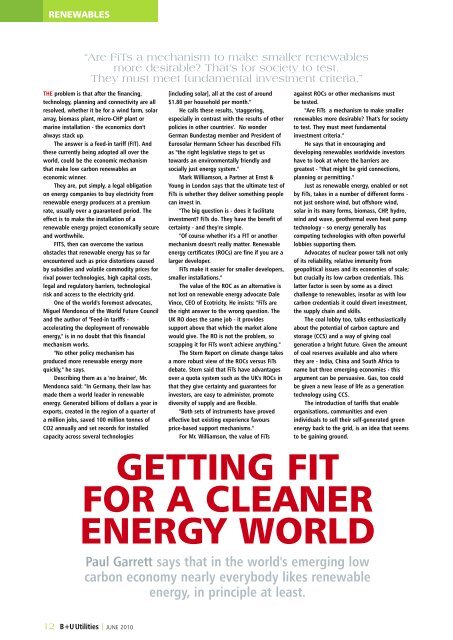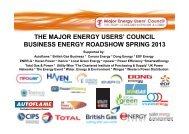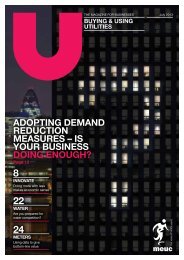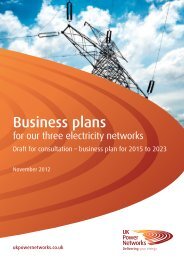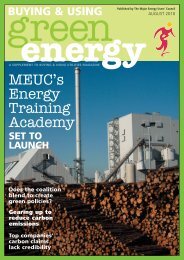CRC - MEUC
CRC - MEUC
CRC - MEUC
Create successful ePaper yourself
Turn your PDF publications into a flip-book with our unique Google optimized e-Paper software.
RENEWABLES<br />
“Are FiTs a mechanism to make smaller renewables<br />
more desirable? That's for society to test.<br />
They must meet fundamental investment criteria.”<br />
THE problem is that after the financing,<br />
technology, planning and connectivity are all<br />
resolved, whether it be for a wind farm, solar<br />
array, biomass plant, micro-CHP plant or<br />
marine installation - the economics don't<br />
always stack up.<br />
The answer is a feed-in tariff (FIT). And<br />
these currently being adopted all over the<br />
world, could be the economic mechanism<br />
that make low carbon renewables an<br />
economic winner.<br />
They are, put simply, a legal obligation<br />
on energy companies to buy electricity from<br />
renewable energy producers at a premium<br />
rate, usually over a guaranteed period. The<br />
effect is to make the installation of a<br />
renewable energy project economically secure<br />
and worthwhile.<br />
FITS, then can overcome the various<br />
obstacles that renewable energy has so far<br />
encountered such as price distortions caused<br />
by subsidies and volatile commodity prices for<br />
rival power technologies, high capital costs,<br />
legal and regulatory barriers, technological<br />
risk and access to the electricity grid.<br />
One of the world's foremost advocates,<br />
Miguel Mendonca of the World Future Council<br />
and the author of "Feed-in tariffs -<br />
accelerating the deployment of renewable<br />
energy," is in no doubt that this financial<br />
mechanism works.<br />
"No other policy mechanism has<br />
produced more renewable energy more<br />
quickly," he says.<br />
Describing them as a 'no brainer', Mr.<br />
Mendonca said: "In Germany, their law has<br />
made them a world leader in renewable<br />
energy. Generated billions of dollars a year in<br />
exports, created in the region of a quarter of<br />
a million jobs, saved 100 million tonnes of<br />
CO2 annually and set records for installed<br />
capacity across several technologies<br />
12 B+U Utilities | JUNE 2010<br />
[including solar], all at the cost of around<br />
$1.80 per household per month."<br />
He calls these results, 'staggering,<br />
especially in contrast with the results of other<br />
policies in other countries'. No wonder<br />
German Bundestag member and President of<br />
Eurosolar Hermann Scheer has described FiTs<br />
as "the right legislative steps to get us<br />
towards an environmentally friendly and<br />
socially just energy system."<br />
Mark Williamson, a Partner at Ernst &<br />
Young in London says that the ultimate test of<br />
FiTs is whether they deliver something people<br />
can invest in.<br />
"The big question is - does it facilitate<br />
investment? FiTs do. They have the benefit of<br />
certainty - and they're simple.<br />
"Of course whether it's a FIT or another<br />
mechanism doesn't really matter. Renewable<br />
energy certificates (ROCs) are fine if you are a<br />
larger developer.<br />
FiTs make it easier for smaller developers,<br />
smaller installations."<br />
The value of the ROC as an alternative is<br />
not lost on renewable energy advocate Dale<br />
Vince, CEO of Ecotricity. He insists: "FiTs are<br />
the right answer to the wrong question. The<br />
UK RO does the same job - it provides<br />
support above that which the market alone<br />
would give. The RO is not the problem, so<br />
scrapping it for FiTs won't achieve anything."<br />
The Stern Report on climate change takes<br />
a more robust view of the ROCs versus FiTs<br />
debate. Stern said that FiTs have advantages<br />
over a quota system such as the UK's ROCs in<br />
that they give certainty and guarantees for<br />
investors, are easy to administer, promote<br />
diversity of supply and are flexible.<br />
"Both sets of instruments have proved<br />
effective but existing experience favours<br />
price-based support mechanisms."<br />
For Mr. Williamson, the value of FiTs<br />
against ROCs or other mechanisms must<br />
be tested.<br />
"Are FiTs a mechanism to make smaller<br />
renewables more desirable? That's for society<br />
to test. They must meet fundamental<br />
investment criteria."<br />
He says that in encouraging and<br />
developing renewables worldwide investors<br />
have to look at where the barriers are<br />
greatest - "that might be grid connections,<br />
planning or permitting."<br />
Just as renewable energy, enabled or not<br />
by FiTs, takes in a number of different forms -<br />
not just onshore wind, but offshore wind,<br />
solar in its many forms, biomass, CHP, hydro,<br />
wind and wave, geothermal even heat pump<br />
technology - so energy generally has<br />
competing technologies with often powerful<br />
lobbies supporting them.<br />
Advocates of nuclear power talk not only<br />
of its reliability, relative immunity from<br />
geopolitical issues and its economies of scale;<br />
but crucially its low carbon credentials. This<br />
latter factor is seen by some as a direct<br />
challenge to renewables, insofar as with low<br />
carbon credentials it could divert investment,<br />
the supply chain and skills.<br />
The coal lobby too, talks enthusiastically<br />
about the potential of carbon capture and<br />
storage (CCS) and a way of giving coal<br />
generation a bright future. Given the amount<br />
of coal reserves available and also where<br />
they are - India, China and South Africa to<br />
name but three emerging economies - this<br />
argument can be persuasive. Gas, too could<br />
be given a new lease of life as a generation<br />
technology using CCS.<br />
The introduction of tariffs that enable<br />
organisations, communities and even<br />
individuals to sell their self-generated green<br />
energy back to the grid, is an idea that seems<br />
to be gaining ground.<br />
GETTING FIT<br />
FOR A CLEANER<br />
ENERGY WORLD<br />
Paul Garrett says that in the world's emerging low<br />
carbon economy nearly everybody likes renewable<br />
energy, in principle at least.


